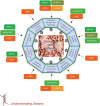The role of Epstein-Barr virus in epithelial malignancies
- PMID: 25251730
- PMCID: PMC4280676
- DOI: 10.1002/path.4448
The role of Epstein-Barr virus in epithelial malignancies
Abstract
The close association of Epstein-Barr virus (EBV) infection with non-keratinizing nasopharyngeal carcinomas and a subset of gastric carcinomas suggests that EBV infection is a crucial event in these cancers. The difficulties encountered in infecting and transforming primary epithelial cells in experimental systems suggest that the role of EBV in epithelial malignancies is complex and multifactorial in nature. Genetic alterations in the premalignant epithelium may support the establishment of latent EBV infection, which is believed to be an initiation event. Oncogenic properties have been reported in multiple EBV latent genes. The BamH1 A rightwards transcripts (BARTs) and the BART-encoded microRNAs (miR-BARTs) are highly expressed in EBV-associated epithelial malignancies and may induce malignant transformation. However, enhanced proliferation may not be the crucial function of EBV infection in epithelial malignancies, at least in the early stages of cancer development. EBV-encoded gene products may confer anti-apoptotic properties and promote the survival of infected premalignant epithelial cells harbouring genetic alterations. Multiple EBV-encoded microRNAs have been reported to have immune evasion functions. Genetic alterations in host cells, as well as inflammatory stroma, could modulate the expression of EBV genes and alter the growth properties of infected premalignant epithelial cells, encouraging their selection during carcinogenesis.
Keywords: BARTs; Epstein-Barr virus; LMP1; gastric carcinoma; lymphoeptithelioma-like carcinomas; nasopharyngeal carcinoma.
© 2014 The Authors. The Journal of Pathology published by John Wiley & Sons Ltd on behalf of Pathological Society of Great Britain and Ireland.
Figures


Similar articles
-
NF-κB Signaling Regulates Expression of Epstein-Barr Virus BART MicroRNAs and Long Noncoding RNAs in Nasopharyngeal Carcinoma.J Virol. 2016 Jun 24;90(14):6475-88. doi: 10.1128/JVI.00613-16. Print 2016 Jul 15. J Virol. 2016. PMID: 27147748 Free PMC article.
-
The Epstein-Barr virus and the pathogenesis of lymphoma.J Pathol. 2015 Jan;235(2):312-22. doi: 10.1002/path.4459. J Pathol. 2015. PMID: 25294567 Review.
-
The role of Epstein-Barr virus infection in the pathogenesis of nasopharyngeal carcinoma.Virol Sin. 2015 Apr;30(2):107-21. doi: 10.1007/s12250-015-3592-5. Epub 2015 Apr 21. Virol Sin. 2015. PMID: 25910483 Free PMC article. Review.
-
Emerging roles of small Epstein-Barr virus derived non-coding RNAs in epithelial malignancy.Int J Mol Sci. 2013 Aug 23;14(9):17378-409. doi: 10.3390/ijms140917378. Int J Mol Sci. 2013. PMID: 23979421 Free PMC article. Review.
-
EBV BART MicroRNAs Target Multiple Pro-apoptotic Cellular Genes to Promote Epithelial Cell Survival.PLoS Pathog. 2015 Jun 12;11(6):e1004979. doi: 10.1371/journal.ppat.1004979. eCollection 2015 Jun. PLoS Pathog. 2015. PMID: 26070070 Free PMC article.
Cited by
-
Current Immune Checkpoint Inhibitor Genetic Biomarker Exploration in Gastrointestinal Tumors.Cancers (Basel). 2022 Sep 30;14(19):4804. doi: 10.3390/cancers14194804. Cancers (Basel). 2022. PMID: 36230726 Free PMC article. Review.
-
The Role of NK Cells in EBV Infection and EBV-Associated NPC.Viruses. 2021 Feb 15;13(2):300. doi: 10.3390/v13020300. Viruses. 2021. PMID: 33671917 Free PMC article. Review.
-
Autocrine INSL5 promotes tumor progression and glycolysis via activation of STAT5 signaling.EMBO Mol Med. 2020 Sep 7;12(9):e12050. doi: 10.15252/emmm.202012050. Epub 2020 Jul 12. EMBO Mol Med. 2020. PMID: 32657028 Free PMC article.
-
Development of Epstein-Barr virus-associated gastric cancer: Infection, inflammation, and oncogenesis.World J Gastroenterol. 2022 Nov 28;28(44):6249-6257. doi: 10.3748/wjg.v28.i44.6249. World J Gastroenterol. 2022. PMID: 36504553 Free PMC article. Review.
-
Relationship between pretreatment concentration of plasma Epstein-Barr virus DNA and tumor burden in nasopharyngeal carcinoma: An updated interpretation.Cancer Med. 2018 Dec;7(12):5988-5998. doi: 10.1002/cam4.1858. Epub 2018 Oct 30. Cancer Med. 2018. PMID: 30378277 Free PMC article.
References
-
- Young LS, Rickinson AB. Epstein–Barr virus: 40 years on. Nat Rev Cancer. 2004;4:757–768. - PubMed
-
- Vockerodt M, Yap L-F, Shannon-Lowe C, et al. The Epstein–Barr virus and the pathogenesis of lymphoma. J Pathol. 2015;235:312–322. - PubMed
-
- Raab-Traub N, Flynn K. The structure of the termini of the Epstein–Barr virus as a marker of clonal cellular proliferation. Cell. 1986;47:883–889. - PubMed
-
- Pittaluga S, Loke SL, So KC, et al. Clonal Epstein–Barr virus in lymphoepithelioma-like carcinoma of the stomach: demonstration of viral genome by in situ hybridization and Southern blot analysis. Mod Pathol. 1992;5:661–664. - PubMed
Publication types
MeSH terms
LinkOut - more resources
Full Text Sources
Other Literature Sources

